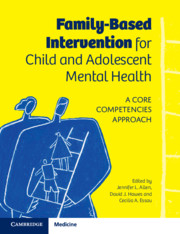Book contents
- Family-Based Intervention for Child and Adolescent Mental Health
- Family-Based Intervention for Child and Adolescent Mental Health
- Copyright page
- Contents
- Contributors
- Preface
- Part I Theoretical Perspectives on Family-Based Intervention
- Chapter 1 A Core-Competency Perspective on Family-Based Intervention for Child and Adolescent Mental Health
- Chapter 2 The Role of the Family in Child and Adolescent Psychopathology
- Chapter 3 Implementation of Family-Based Intervention
- Chapter 4 Effective Components of Parenting Programmes for Children’s Conduct Problems
- Part II Core Clinical Competencies
- Part III Family Intervention for Specific Child and Adolescent Mental Health Problems
- Part IV Family Intervention for Children at Risk Due to Family Dysfunction or Past Adversity
- Part V New Developments in Family-Based Intervention
- Index
- References
Chapter 3 - Implementation of Family-Based Intervention
Current Status and Future Directions
from Part I - Theoretical Perspectives on Family-Based Intervention
Published online by Cambridge University Press: 18 February 2021
- Family-Based Intervention for Child and Adolescent Mental Health
- Family-Based Intervention for Child and Adolescent Mental Health
- Copyright page
- Contents
- Contributors
- Preface
- Part I Theoretical Perspectives on Family-Based Intervention
- Chapter 1 A Core-Competency Perspective on Family-Based Intervention for Child and Adolescent Mental Health
- Chapter 2 The Role of the Family in Child and Adolescent Psychopathology
- Chapter 3 Implementation of Family-Based Intervention
- Chapter 4 Effective Components of Parenting Programmes for Children’s Conduct Problems
- Part II Core Clinical Competencies
- Part III Family Intervention for Specific Child and Adolescent Mental Health Problems
- Part IV Family Intervention for Children at Risk Due to Family Dysfunction or Past Adversity
- Part V New Developments in Family-Based Intervention
- Index
- References
Summary
This chapter reviews the current status of implementation efforts in the field of family-based interventions for child and adolescent mental health. First, an overview of the implementation framework is provided, with an emphasis on the theoretical models that have previously been applied to family studies. Next, a comprehensive framework which integrates the common findings of individual models is introduced. Thereafter, specific research on the implementation of family-based intervention is reviewed. Strongest evidence exists for treatment fidelity and staff training as factors promoting successful implementation. Although some studies indicate that program fit with organizational characteristics is an important factor in both the adoption and sustainment phases, studies examining moderating effects between potential factors influencing the implementation process are lacking at this time. Future studies need to pursue implementation factors unique to family-based programs, as well as develop a consensus on the terminology and operational definitions of relevant constructs and sound methodology for measurement.
Keywords
- Type
- Chapter
- Information
- Family-Based Intervention for Child and Adolescent Mental HealthA Core Competencies Approach, pp. 29 - 39Publisher: Cambridge University PressPrint publication year: 2021
References
- 1
- Cited by



